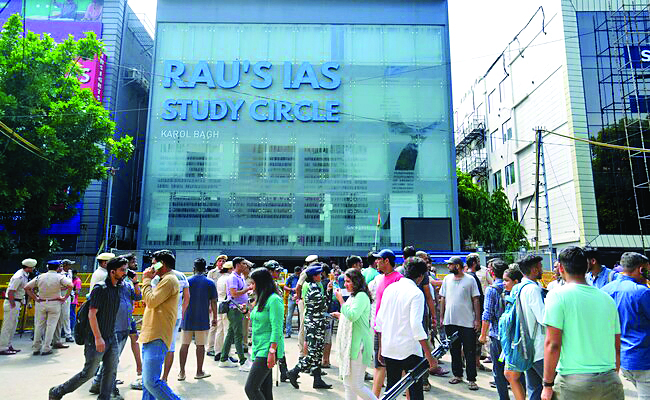The tragic death of three civil services aspirants at the basement of their coaching centre in Delhi’s Old Rajinder Nagar area because of sudden flooding caused by heavy rain is symptomatic of the rot that is crippling our system. It is like a vicious cycle where the authorities are either incompetent or compromised, and the citizens know how easy it is to bend the system in exchange for money. It is a case of feeding off each other, which is corroding the system. It is only after the sad incident in which three young lives were lost that it has come to light that the RAU IAS Study Circle was not the only coaching centre to violate building bylaws by running its centre from the basement, which was on paper meant to be used for storage and a garage. The Municipal Corporation of Delhi (MCD) sealed as many as 13 such coaching centres for running their operations from the basement. Basic safety measures were not taken by RAU, whose basement had only one entry and exit point, which was biometrically controlled. Once the biometric system malfunctioned because of the flooding, the three students got trapped inside. The problem is that it’s only when such incidents take place that the authorities wake up to discover how rules have been flouted. Being proactive after such an incident has taken place is not acceptable. The MCD is saying that it is not possible to know how rules are being flouted after clearance has been given. This is difficult to believe. The Old Rajinder Nagar area is teeming with IAS coaching institutes, with buildings standing cheek by jowl. Almost all of them flout some building bylaw or the other. Why couldn’t the raid, which was conducted after the incident, couldn’t be conducted earlier? Why aren’t there regular/periodic inspections or surveys of such commercial areas?
The same apathy is seen when it comes to preventing waterlogging. The MCD says that it is discovering only now that the storm drains in the area have been covered and have been encroached on by residents and shopkeepers, resulting in the huge flooding that took place on Saturday. This too is difficult to believe, when MCD has local corporators on the ground, who should have proactively stopped such encroachments. All these violations are taking place right under their nose. It seems the MCD does not carry out even the bare minimum anti encroachment drives to ensure that the roads of the national capital stay free of encroachers. It’s the same story every monsoon, and not just in the affected area.
Drains all over the national capital are rarely de-silted. The Public Works Department, whose job it is to carry out such de-silting, says that it has been carrying out such drives, but it does not seem to be doing an effective job. As a result of which most of Delhi’s storm water drains are clogged and even a modest burst of rainfall results in flooding. As it is, the drainage system in Delhi is not equipped to handle even a moderate downpour. Delhi is still operating on a 1976 drainage master plan, according to which it can barely handle 50 mm rainfall in a period of 24 hours. This has to be seen in context of the 228 mm rainfall Delhi received in the space of 24 hours on 27-28 June, wreaking havoc. In fact, the city gets crippled even with much less rainfall. In April 2023, the PWD said that it would be drawing up a new drainage master plan for Delhi, but that exercise is likely getting caught in procedural delays. And if this is the situation in the capital city of the country, imagine the condition in other cities with much less funds at their disposal.
In fact, this state of affairs goes beyond politics. The MCD is as inefficient under the Aam Aadmi Party as it was under the Bharatiya Janata Party. Nothing has changed. Same is the case with almost all municipalities across the country, whichever be the party in power there. Our urban planning, which is mostly rooted in the British era, is a shambles. This is not how the cities of a rising power like India should be. While roads, flyovers, highways, ports are giving a push to the country’s growth, our cities are becoming unlivable and are thus hindering progress. Cosmetic beautification of the cities does not work beyond a point. A complete revamp of urban planning is needed, including increasing manifold the building of newer centres of economic activity, so that our big cities do not have to bear “alone” the burden of the huge population that tends to descend on them for livelihood.
Most importantly, what is needed is accountability, which the system does not seem to have at present.























